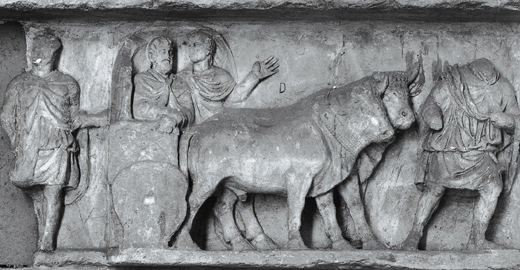
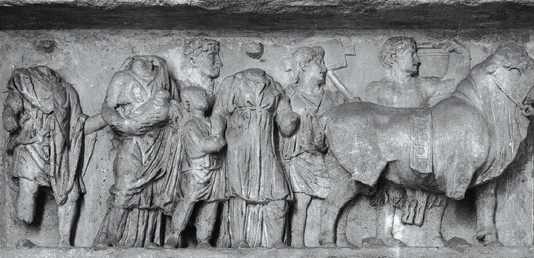
Scholars have long recognized that the Evangelists do not simply report the events of Jesus’ life. They select, arrange and modify material at their disposal to stress important themes—like the connection between Jesus and the Old Testament, the inclusion of gentiles in the kingdom and the nature of discipleship.
Mark’s gospel was probably written for gentile Christians living in Rome. Could this audience have understood the various allusions to the Hebrew Bible worked into Mark’s narrative? On the other hand, Mark’s contemporaries might well have grasped a pattern of meaning that has gone unrecognized by modern Bible commentators: In Mark’s gospel, the crucifixion procession is a kind of Roman triumphal march, with Jerusalem’s Via Dolorosa replacing the Sacra Via of Rome. In this way, Mark presents Jesus’ defeat and death, the moment of his greatest suffering and humiliation, as both literally and figuratively a triumph.
Here we will examine more closely the crucifixion procession as described in Mark 15:16–39 (see the sidebar to this article). But first let’s look at the triumphal march, especially the features with which Mark’s first-century A.D. Roman contemporaries would have been familiar.
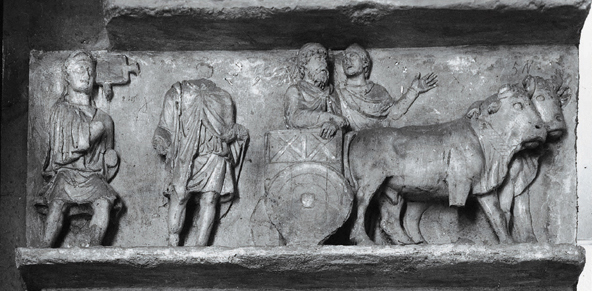
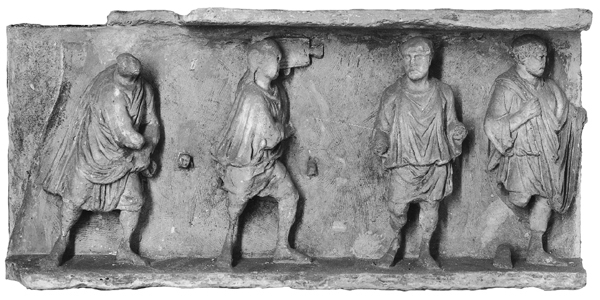
The triumph was a celebration in which victorious generals and emperors paraded through Rome, putting their accomplishments on display for the populace. It evolved from Etruscan and Greek ceremonies calling for an appearance, or epiphany, of Dionysus, the dying and rising god.1 In the Athenian New Year festival, Dionysus, portrayed in costume by the king, was carried into the city in a formal procession, which culminated in a cry for the epiphany of the god (in Greek, thríambos; in Latin, triumpe). A bull was then sacrificed, and the king appeared as the god. In Greece, Zeus eventually supplanted Dionysus; the shift probably occurred because of Zeus’s position as king of the gods.
The Roman historian Dio Cassius describes an early Roman triumph after which subsequent processions were patterned. First, the soldiers proclaimed a victorious general imperator, and the senate decreed a triumph. The triumphator appeared “arrayed in the triumphal dress and wearing armlets, with a laurel crown upon his head, and holding a branch in his right hand.” He called together the people, praised the gathered soldiers, distributed gifts and then mounted a tower-shaped chariot, where a slave held a crown over his head. The triumphator was preceded into the city by captives displaying graphic representations of his victories. Finally, “the victorious general arrived at the Roman Forum, and after commanding that some of the captives be led to prison and put to death, he rode up to the Capitol. There he performed certain rites and made offerings and dined in the porticos up there, after which he departed homeward toward evening.”2
The connection between the triumphator and Jupiter (the Roman equivalent of Zeus) is remarkable. The triumphal robe, a garment of regal purple embroidered with gold, and the gold laurel wreath were both borrowed from the statue of the god in the temple Jupiter Capitolinus. The face of the triumphator was painted red in imitation of the same statue. The crowd cried triumpe, a call for the manifestation of the god. During the Roman republic, however, the triumphator was only recognized as under the tutelage of the god. The identification of the king with the deity would come later.
In the latter period of the Roman republic, as successive triumphators attempted to align themselves with, and even upstage, military heroes of the past, the processions became more complex, overlaying traditional ceremonial elements with increasingly gaudy and lavish displays.3 After about 20 B.C., the triumph became the exclusive privilege of the emperor. Now it was a tribute to an all-powerful individual, who, upon his accession, might well celebrate his conquest of Rome rather than his conquest for Rome or might manufacture any pretense for a display of power. Ultimately, for the mid-first-century tyrants Gaius (more familiarly known as Caligula) and Nero, this privilege brought the triumph together with the notion of the imperator’s own deification. Thus the ceremony became reconnected with its roots as a display of the ruler as a god.
It is in this relation between triumph and deity that the most profound connection with the Gospel of Mark emerges. Even prior to Mark’s gospel (before about 70 A.D.), Christ was understood as a triumphator. In 2 Corinthians 2:14–15, Paul proclaims:
Christ always leads us in triumphal procession, and through us spreads in every place the fragrance that comes from knowing him. For we are the aroma of Christ to God among those who are being saved and among those who are perishing.
Even the references to scent may evoke the image of first-century triumphs, which included the distribution of aromatic substances along the route of the procession to signify the preservation of the life of the triumphator and possibly the death of his captives, some of whom would be killed.4 Whether or not Paul extends the metaphor, there can be no mistaking his allusion to Christ as triumphator.
Mark’s crucifixion narrative contains a number of striking parallels to the Roman triumph. While the cumulative force of the comparison is significant, the most obvious allusions are made at the beginning of the narrative, perhaps signaling to Mark’s audience that there is more to come for those “on the inside” (compare Mark 4:11).
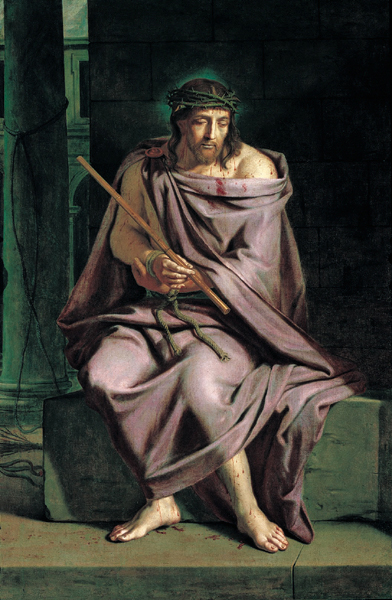
Mark’s narrative begins with the Roman soldiers leading Jesus into “the courtyard of the palace.” The word Mark uses to refer to this place is praetorium, which could apply to military headquarters in general (for example, in Acts 23:35) but was also the common designation in Rome for the place and personnel of the imperial guard. The praetorian guard, which made or broke the power of emperors, was invariably present on the occasion of a triumph, and, significantly, it was called together en masse. If it were not for this custom of mustering the praetorian guard, we might think that Mark’s naming of the palace courtyard as the praetorium is simply an incidental detail. But Mark then tells us that “they called together the whole cohort.” It would be extremely odd for the entire soldiery (at least 200 men) to be called together to mock and beat a single prisoner. Rather, we should consider the details here as carefully chosen to evoke a familiar occasion, namely, the gathering of the soldiery in preparation for a triumphal march.
Contemporaneous accounts of Roman triumphs suggest that Mark’s description of Jesus’ clothing (“They clothed him in a purple cloak; and after twisting some thorns into a crown, they put it on him” [Mark 15:17]) follows a formula. In one source after another, the triumphator is introduced clad in a ceremonial purple robe and a crown.5 The wearing of purple was outlawed for anyone below equestrian rank. The only available robe of this kind for Jesus would belong to Pilate, but it is inconceivable that he would lend his garment to be spat on by soldiers. Along similarly practical lines, one wonders where in the courtyard of a palace thorns would be available to make a crown. Are we to imagine that the soldiers delayed their mockery while someone went to look for a thornbush? The strangeness of these details, their likeness to the ceremonial garb of a triumphator and their combination with other details of the narrative suggest purpose rather than coincidence.6
Before the procession began, when the triumphator appeared in ceremonial garb, he would meet with the soldiers to receive their accolades. So in Mark’s gospel the immediate sequel to the appearance of Jesus in royal garb is the mock homage of the soldiers (“They began saluting him”). Their shout, “Hail, King of the Jews!” (Mark 15:18), may in fact correspond to a formulaic response in a triumph.7
As the soldiers lead Jesus along the Via Dolorosa, they compel an onlooker, Simon, to bear the cross. Simon is identified as from Cyrene (a Greek colony in North Africa) and as the father of Alexander and Rufus, who were probably known to Mark’s audience as church figures (Romans 16:13; 1 Timothy 1:20; 2 Timothy 4:14). The account of Simon’s requisition by the soldiers as cross-carrier may serve simply to suggest the wearying effect of a prolonged procession. But it may also suggest another formulaic element in a triumph. A consistent feature in the numerous monuments depicting triumphs is the sacrificial bull, led along dressed and crowned to signify its identity with the triumphator. But the bull is not alone. In nearly every one of these depictions, walking alongside the bull is an official who carries over his shoulder a double-bladed ax, the instrument of the victim’s death. The parallel might appear to be coincidental, but two remarkable details—Simon’s link to the community of faith via his sons and his having just arrived from out of town—suggest that Mark envisions his role as divinely planned. Like the official who bears the ax, Simon carries the instrument of the sacrifice’s—in this case Jesus’—death: the cross.
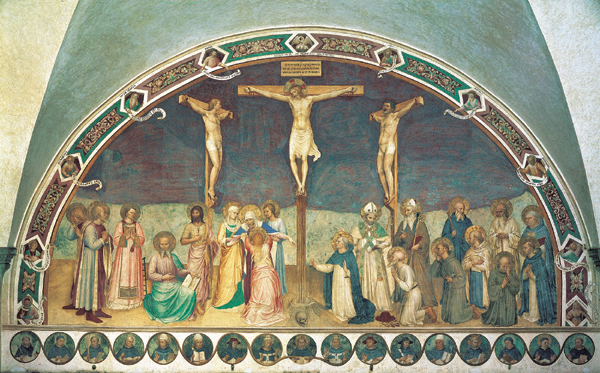
Crucifixions were common enough in the Roman world that major cities set aside special places for them. The crucified bodies, in various stages of suffering or decomposition, provided a public warning to potential malefactors. In Rome, the place was the Campus Esquilinus; in Jerusalem, it may have been either the site of the present Church of the Holy Sepulchre or on the Mount of Olives, across the Kidron Valley from the Temple. Mark gives the name of the place, Golgotha; then, untypically, he translates it for his readers: “which means the place of a skull.” In Hebrew Golgotha denotes not an empty skull but more generally the head. This is also true of the Greek translation. Therefore, “place of the head” or perhaps “place of the death’s-head” would be a more accurate rendering.8
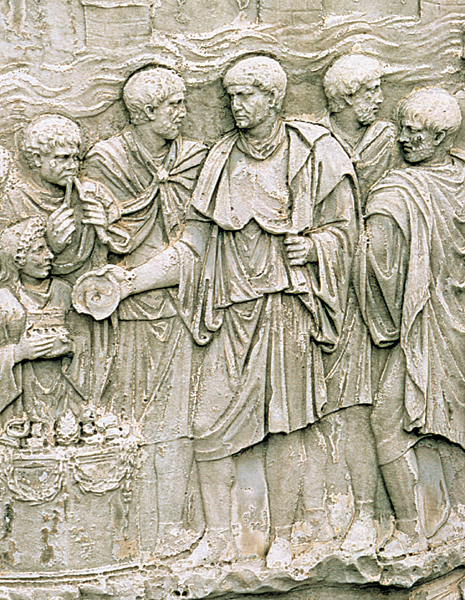
Mark may be offering this translation simply to heighten the sense of the macabre. But there is a remarkable coincidence in the name of the place that may constitute another allusion to the triumph. Dionysius of Halicarnassus records the legend that, during the laying of a foundation for a temple on a certain Roman hill, a human head was discovered with its features intact. Soothsayers proclaimed:
“Romans, tell your fellow citizens it is ordered by fate that the place in which you found the head shall be the head of all Italy,” (and) since that time the place is called the Capitoline hill from the head that was found there; for the Romans call heads capita.9
The temple of Jupiter Capitolinus, or more simply the Capitolium, was the terminus of every Roman triumph. The procession would wind through the streets to the Forum, culminating in the ascent of the triumphator to the place of sacrifice—the place named after a death’s-head. The name “Golgotha” (head) may simply be a linguistic and historical coincidence, but to an audience prepared by the context of Mark’s gospel to look for double meanings, it would be a glaring and meaningful coincidence: Golgotha was the Capitolium (head) to which the triumphator ascended.
Before reaching Golgotha, the soldiers offer Jesus myrrhed wine, but he refuses to drink (Mark 15:23).10 Why the offer of this expensive delicacy, why the refusal, and why interject this seemingly trivial detail here?
The supreme moment of the triumph is the moment of sacrifice, depicted in detail by numerous sculptors of the period. Just prior to the sacrifice of the bull, or in a few cases simultaneous with the sacrifice, the triumphator was offered a cup of wine, which he would refuse and then pour on the altar (or, more rarely, on the bull itself). The wine obviously signifies the precious blood of the victim, and the links between triumphator, wine and victim signify their connection—which is also confirmed by the similar dress worn by both the triumphator and the bull. In other words, the bull is the god who dies and appears as the victor in the person of the triumphator.
All of this is shorthand for a long process of ritual development, but for our purposes the formulaic element is clear. At the crucial moment of a triumph, the moment of sacrifice, expensive wine is poured out. Significantly, the very next words in Mark’s account are “and they crucified him.” This again suggests a close association between wine and sacrifice. In an earlier scene in Mark’s narrative, the Last Supper, Jesus himself makes the connection between the drinking of wine, sacrifice and triumphant renewal: “He said to them, ‘This is my blood of the covenant, which is poured out for many. Truly I tell you, I will never again drink of the fruit of the vine until that day when I drink it new in the kingdom of God’” (Mark 14:24–25). The refusal of wine is one of the many details suggesting that the painful humiliation of the crucifixion is in fact a victorious triumph.
Another remarkable detail reported by Mark is that Jesus is executed with “two bandits, one on his right and one on his left” (Mark 15:27). This account not only appears to be an unnecessary interruption of the narrative but also draws the attention of readers to the shamefulness of the crucifixion. Why accentuate the scandal of the cross by associating Jesus with criminals?
In the world of Mark’s audience, placement on the right and left of an elevated person signified royal enthronement. Earlier in Mark’s narration, for example, he tells us that two disciples request to be seated on Jesus’ right and left when he is enthroned (Mark 10:37). In the triumph itself, the triumphator is normally alone, but the few exceptions are notable both because they occur at the point of elevation to the rostrum and because they occur very near to the time of Mark’s writing.
Suetonius, a Roman historian of the early second century, records a triumph of the youthful Tiberius, who “took his seat beside Augustus between the two consuls.”11 In 44 A.D., Claudius returned to Rome after a military campaign and celebrated a triumph. “In this he followed precedent, even ascending the steps of the Capitol on his knees, with his sons-in-law supporting him on either side.”12 When Vitellius accepted the title “imperator” at Lugdunum in 68 A.D., he “spoke in praise of [his conquering generals] Valens and Caecina in public assembly and placed them on either side of his own curule chair.”13 In 71 A.D. Vespasian celebrated his triumph over the Jews with Titus beside him in the triumphal chariot and Domitian riding alongside;14 the three then performed together the culminating events of the triumph.15
In each of these instances, a threesome appears elevated above an admiring throng in order to express power through solidarity. It is probable, then, that the crucifixion of criminals on either side of Jesus is a conscious expression of the mockery of his kingship on the part of the soldiers. That is, they are the mock equivalent of those displayed on either side of an enthroned ruler.
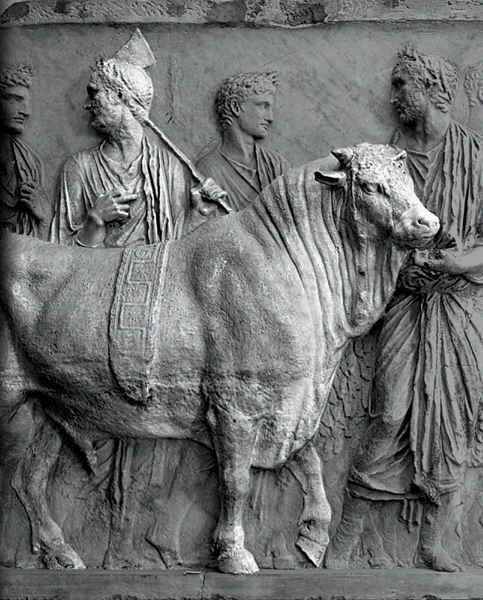
To summarize Mark’s narrative as now decoded: The praetorian guard gathers early in the morning to proclaim the triumphator. They dress him in the purple triumphal garb and place a crown of laurel on his head. The soldiers shout in acclamation of his lordship (“Hail, King of the Jews” [Mark 15:18]) and perform acts of homage to him. They accompany him through the streets of the city. The sacrifice walks alongside a person who carries the implement of the victim’s death. The procession ascends to the place of the (death’s) head, where the sacrifice is to take place. The triumphator is offered ceremonial wine. He does not drink it but pours it out on the altar at the moment of sacrifice. Then, at the moment of being lifted up before the people, at the moment of the sacrifice, the triumphator is again acclaimed as lord (“The King of the Jews” [Mark 15:26]), and his viceregents appear with him in confirmation of his glory. The epiphany of the triumphator is accompanied by divine portents (“The curtain of the Temple was torn in two” [Mark 15:38]), confirming that he is one with the gods.
The opening sentence of Mark’s gospel identifies Jesus as “the Son of God,” but no human voice gives him that title until after he dies. Struck with wonder as he watches Jesus breathe his last, a Roman centurion gasps, “Truly this man was God’s Son!” (Mark 15:39). The moment of Jesus’ death, the moment of his sacrifice, is the culmination of Mark’s parable of triumph. But Mark presents the crucifixion as an “anti-triumph”—with Jesus mocked and killed—to show that the seeming scandal of the cross is actually an exaltation of Christ.
Mark’s anti-triumph, I would argue, was composed in reaction to the self-deification of the emperors Gaius (37–41 A.D.) and especially Nero (54–68 A.D.). Gaius would regularly visit the temple of Jupiter Capitolinus to engage in confidential chats with the deity.16 He required that courtiers hail him as Jupiter and built a temple to his own godhead containing a statue with whom he regularly exchanged clothing. Similarly, Nero’s conduct in public triumphs confirms his own flirtation with divinity. At the culmination of one procession, King Tiridates paid obeisance to Nero by saying, “I have come to thee, my god, to worship thee as I do Mithras.”17 On this occasion, Nero was dressed in triumphal garb, and the canopy over his head depicted him in the attitude of the god, “driving a chariot, with golden stars gleaming all about him.”18 During another triumph, Nero was hailed as, among other things, Apollo and “Divine Voice.”19
As these events were occupying center stage in Rome, members of the Roman church were struggling to understand and communicate the notion that God had revealed himself in the person of Jesus, who was understood as both the Crucified One and the Coming One. It would have been natural for them to make comparisons between the Lord Christ and the Lord Caesar, and it would have been natural for them to look for evidence of God’s sovereignty in Jesus’ humility. Is it not plausible that Mark would arrange some of these details to hint at a correspondence between the mockery of Jesus and the empty, futile adoration of the imperator? For Mark, it is the mocked Jesus, not the gaudy Roman emperor, who is the true epiphanic triumphator.
An earlier version of this article appeared in New Testament Studies 41:1 (January 1995). This article has been reprinted with the permission of Cambridge University Press.
MLA Citation
Endnotes
Dio Cassius 6.23 (see Zonaras 7.21). For other accounts, see Livy, Epitome 10.7.10; Juvenal, Satires 10.36; and Servius’s commentary on Virgil’s Eclogues 6.22.
See, for example, Livy, Epitome 1.10.5; 10.7.9; Dionysius of Halicarnassus, Roman Antiquities 2.34.2; Dio Cassius 51.21.8–9; and Suetonius, Nero 25.
At the same time that Mark appeals to his gentile audience by utilizing imagery from the Roman triumphal march, he inserts allusions to the Hebrew Bible. After the Roman soldiers mockingly salute Jesus, his regal clothes are removed, and his own clothes are put back on him (Mark 15:20). Although this is inconsistent with the custom of the triumphator’s wearing of the ceremonial robe throughout the procession, it is necessary to keep in motion another pattern of allusions—to Psalm 22, which speaks of one “scorned…and despised by the people. / All who see me mock at me” (verses 6–7). After crucifying Jesus, the Roman soldiers then cast lots for his garments. This is another allusion to Psalm 22: “They divide my clothes among themselves, / and for my clothing they cast lots” (verse 18).The imagery drawn from this psalm reaches its dramatic climax just a few verses later in Mark’s crucifixion narrative, after Jesus has been nailed to the cross: “Jesus cried out with a loud voice, ‘Eloi, Eloi, lema sabachthani?’ which means, ‘My God, my God, why have you forsaken me?’” (Mark 15:34). These are the first words of Psalm 22.
Although we do not have an explicit record of such a response, Suetonius may provide a hint when he reports that during a procession of Nero’s, his escort “shouted that they were attendants of Augustus and the soldiers of his triumph” (Nero 6.25).
The Vulgate calvaria (as opposed to caput), the ambiguity of the English word “head” and the popular image associated with Gordon’s Calvary may exert undue influence on modern translations.
Pliny describes myrrhed wine as the finest (Naturalis Historia 14.92). Sour wine or vinegar, as in Mark 15:36, was understood to deaden pain (Pliny, Naturalis Historia 23.24–27), but while the ancients often describe the sedative effect of myrrh alone or in combination with other ingredients, none ascribe such an effect for myrrhed wine. Wine mixed with myrrh was an expensive delicacy that probably was not understood to deaden pain.

